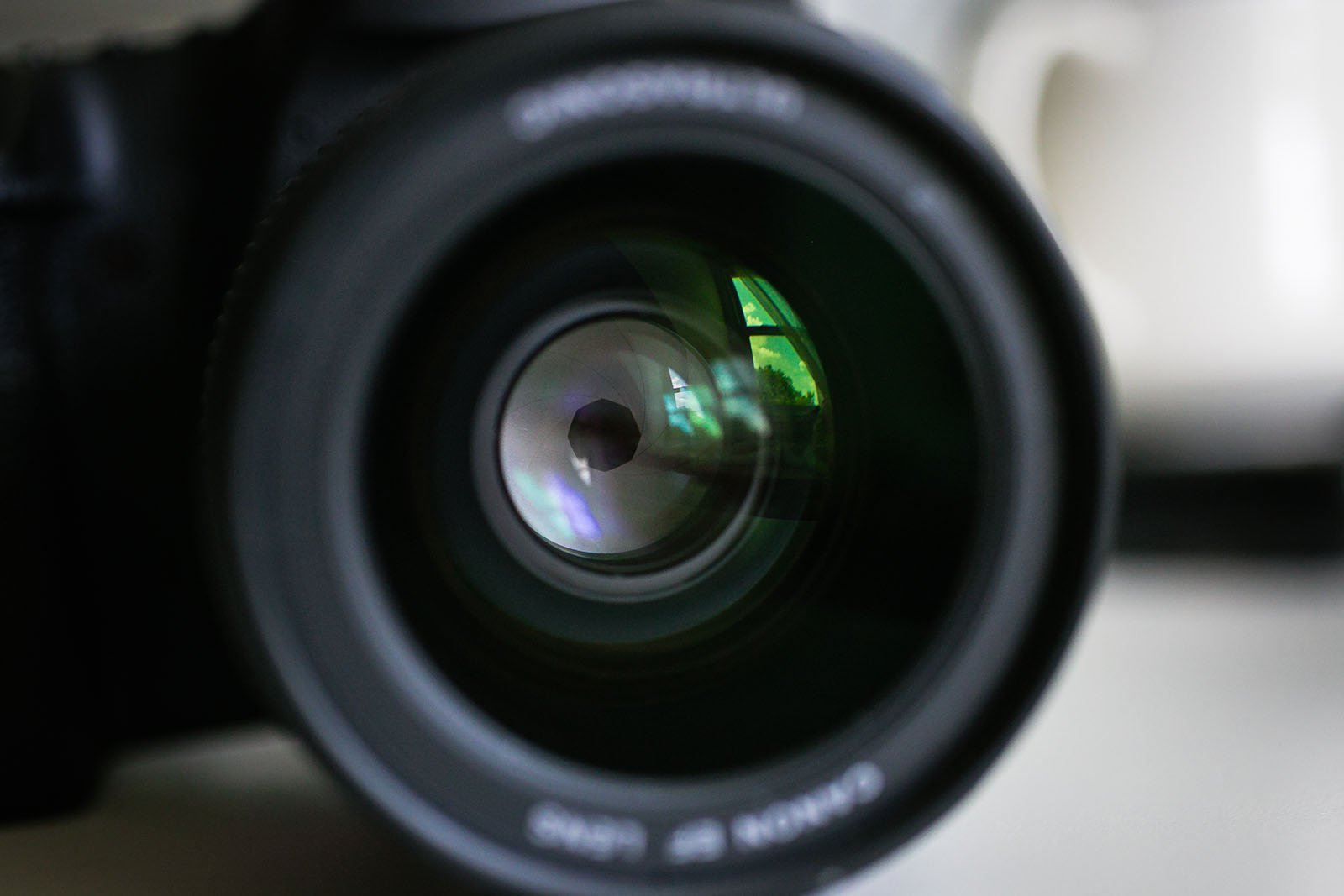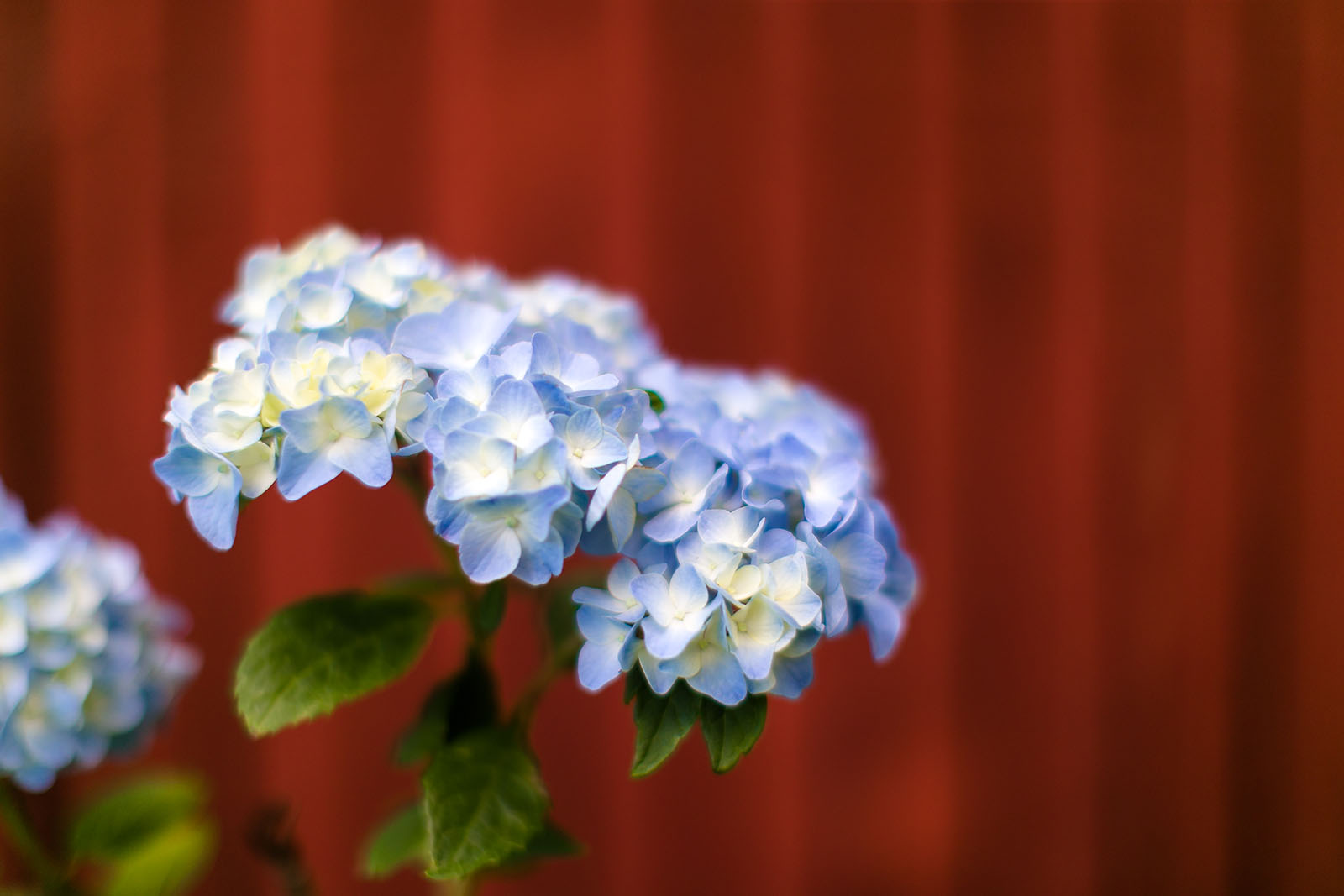You’ve heard of the word aperture but what is it, exactly?
Aperture is one very important part of what photographers call the exposure triangle, the relationship between ISO, shutter speed, and aperture.
These three settings work together to control the overall exposure of an image. When one goes up, another must go down in order to maintain the proper exposure.

The aperture is like the pupil of your eye
The photograph above shows a camera shutter “closed down” to take a photo (no shutter is actually 100% closed because than no light at all could enter). Notice the hole in the middle? The size of that opening is the aperture, and it’s measured on a scale of millimeters. The size of the hole lets more or less light into the camera, like your pupils.
When you walk outside on a bright sunny day, your eyes are being inundated with light. You’ll squint and hold your hand up to block the light while your eyes adjust, shrinking your pupils. Once your pupils are tiny little black dots, it becomes a little easier for you to see because less light is able to get into your eye.
The opposite occurs when you enter a dark room at night. With little light to help you see, your eye adjusts resulting in large pupils, which let in as much light as possible. After a few minutes, your eyes have adjusted and you can see more detail than you could when you first entered the dark room.
Keeping this analogy in mind, imagine your camera’s aperture as the pupil. Only instead of the aperture automatically adjusting based on lighting conditions like your pupil does, in manual shooting modes you must act as the brain for the camera and make the adjustments manually.
Aperture and depth of field
Unlike shutter speed and ISO, aperture is unique in that it affects both light and depth of field, which makes it a setting often adjusted for practical and artistic purposes.
Returning to the eyeball analogy, I’ll propose another scenario. You’re at a café and there’s a specials board across the room. You can’t quite make out what it says but your seat is blocked in making it more trouble than it’s worth to try and get up, so you squint. Ah, much better. The steak fries are on special today!
Without getting into how a lens works, when you squint, you’ve effectively stopped down the aperture of your pupil, or made it smaller. So not only is less light entering your pupil but the way light enters your pupil and focuses inside your eye creates a slightly clearer image across your field of vision.
The same thing happens when you stop down the aperture on your camera. An image taken at f/2.8 is going to have a smaller depth of field, or area in which the image is in focus, resulting in that blurred background which we call bokeh.
Portrait photographers will often shoot “wide open”, keeping the focus on the subject’s eyes and letting the rest of the face and background fall off into blur in order to limit distractions. On the other hand, landscape photographers prefer shooting “stopped down” to f/16 or f/22. The resulting image has a larger depth of field and the entire image (relatively speaking) is crisply focused.

Aperture: f/1.2

Aperture: f/16
Tying it all together
Okay, so how do you know what f-stop to choose for your photos? Start by experimenting on your favorite lens.
Working in Av mode, select the widest aperture the lens can handle, whether that’s 1.8 or 2.8 or 4. Set your camera’s ISO to auto, then find a subject and take a photograph. Stop your aperture down a few notches, take another photo, and continue the cycle until you can no longer stop down. The camera will adjust the shutter speed for you to keep the exposure consistent.
On your camera’s LCD screen, you should be able to display the settings for each image as you view them (my Canon 6D has an INFO button, but check your camera’s manual). Note what has changed as you look through the series of images. The background should come into focus as your aperture gets smaller and the shutter speed (Tv) should have gotten longer to compensate for less light coming into the smaller aperture opening.
Your camera always wants to give you a proper exposure, so as you change the aperture along the way, the camera adjusts elsewhere. When you eventually move to full manual mode (M), you’ll have to make those adjustments on your own.
Eventually you may get to a point where you may have a preferred f-stop to use, or maybe you’ll find a ‘sweet spot’ on a particular lens. Folks who prefer to shoot ‘wide open’ or close to it often do so because of the extra light that comes into the camera.
Shooting with a wide aperture like f/1.2 with its very narrow depth of field can result in a more ethereal, dreamy sort of look that you can’t get at f/22. Alternatively, landscape photographers will usually stop down their aperture so that they can achieve crisp images with a large depth of field, so that the fore, mid, and background are all in focus. On darker days, this means adjusting the shutter speed and/or ISO to make up for the light lost with that tiny aperture opening.
When selecting your aperture, ask yourself a few questions:
- What is my environment like?
- Am I indoors on a cloudy day, or outdoors in bright sunlight?
- What kind of look am I trying to achieve?
- Do I want the background to fall out of focus quickly or am I trying to photograph an entire scene in focus?
- What is the subject I am trying to photograph?
As with everything in photography, practice as much as you can. Digital cameras make it easy to experiment over and over, so play around with various apertures to get a feel for how they work with light.
Flip through a photography magazine like Click – they’ve helpfully included the camera settings with most of the images featured, which will help you build that mental relationship between aperture and depth of field.
The math and science behind aperture
What is an f-stop? Why is aperture written with an f/ in front of it? Why are the smaller numbers considered larger apertures?
Let’s get nerdy for a minute. After all, with a background in math and science, I feel like I owe it to myself to dig into optics for a bit.
Don’t let this scare you off! You won’t need to memorize equations, but I think they’re helpful to see in order to understand aperture. Some smart folks at your camera’s manufacturing company put these equations into the camera’s innards so all you need to do is pick a focal length and an f-stop number, and it figures out the actual aperture (diameter) for you.
Go back to the image of the ‘closed’ shutter. The size of that opening has a diameter (which we call aperture), expressed in equation form as D. If you need a refresher in math, the diameter is the distance from one side of a circle to the other side. Your camera uses the following equation to figure out how large or small to make the diameter/aperture:
D = Focal Length (f) / Stop Number (S)
Let’s break that down now. Based on your choice of lens, your focal length may be adjustable (like on a zoom lens) or fixed (like on a prime). I’ll use a prime 50mm lens for an example.
Say I turn my camera on in Aperture Priority (Av) mode. I’ll select a value, called the f-stop number, and the camera will adjust the shutter speed for me to maintain a proper exposure. I select a random f-stop of 4.
Remember the equation above: Diameter = Focal Length / Stop Number. If f=50mm, and the stop number is 4, the diameter of the opening will be 50/4, or 12.5mm. The shutter will close down enough to leave an opening 12.5mm across to let light flow into the camera’s sensor.
But when have you ever seen or heard a photographer refer to their aperture as 12.5mm? Because the amount of light necessary to reach the sensor depends on the focal length (in this case 50mm), it’s easier to express aperture as a fraction paired with the focal length (e.g. 50mm at f/4).
Aperture vs f-stop
While the terms aperture and f-stop are often used interchangeably, they are actually two different parts of the same equation. The aperture is the diameter of the opening, or pupil, in the lens, shown in the equation as D.
The f-stop number (S in the equation above), while it seems arbitrary, is actually a way to dictate how much light should come into the camera based on the focal length. With each move up or down in the f-number scale, the amount of light will either double or halve. f/2.8 creates an aperture with double the area of f/4 given the same focal length, and thus double the amount of light can enter the camera. f/4 will allow for double the area/double the light of f/5.6. And so on, and so forth.

This is why your aperture value is written as f/4 (or 2.8, 5.6, 8, etc) – it’s actually a fraction! The f is just standing in, algebra style, waiting for you to choose a focal length. Your camera will then determine how large or small to open the aperture.
Now that you know that the fancy f isn’t just there for aesthetics – it represents the focal length you choose based on your lens – let’s create another example. We’ll use the same 50mm lens but choose a different f-stop, like 2.8. Written as f/2.8, we know that f is 50mm. So 50/2.8 = 17.8 mm.
When using a 50mm lens, the opening of your shutter will be 17.8 mm across if you choose f/2.8, and only 12.5mm across if you choose f/4. We’ll stick with the diameter rather than figuring out the area but remember the area of f/2.8 is double the size of f/4.
In either case, this explains why a seemingly smaller stop number like f/2.8 results in a larger diameter/aperture opening, than a higher number like f/4. The aperture is actually a fraction, and just like 1/2 teaspoon is larger than 1/4 teaspoon, f/2.8 is larger than f/4. The opening is wider and if all other pieces of the exposure triangle (ISO and shutter speed) remain the same, more light will enter the f/2.8 aperture resulting in a brighter image.

f/3.5 in Av mode

f/7.1 in Av mode
The post What is aperture? A beginner’s guide for photographers appeared first on Clickin Moms.






